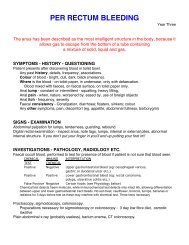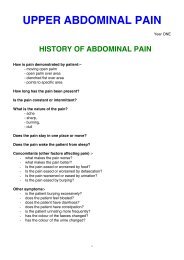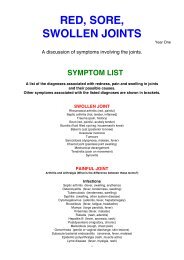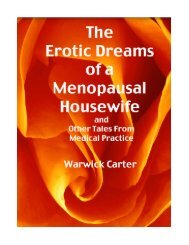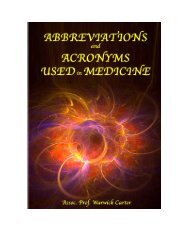Menopause A to Z.pdf - Medwords.com.au
Menopause A to Z.pdf - Medwords.com.au
Menopause A to Z.pdf - Medwords.com.au
You also want an ePaper? Increase the reach of your titles
YUMPU automatically turns print PDFs into web optimized ePapers that Google loves.
MENOPAUSE A <strong>to</strong> Z<br />
ATROPHIC VAGINITIS<br />
Atrophic, postmenop<strong>au</strong>sal or senile vaginitis is a lack of vaginal moisture and lubrication. The vagina is kept moist<br />
by the production of mucus from glands in and around it, that be<strong>com</strong>e more active during sexual stimulation. After the<br />
menop<strong>au</strong>se the female hormone oestrogen, is no longer produced by the ovaries. This hormone stimulates the vaginal<br />
glands <strong>to</strong> produce mucus, but without oestrogen, they do not function. Blood tests can be used <strong>to</strong> measure the<br />
oestrogen level<br />
It is usually a condition of older women who <strong>com</strong>plain of a dry, sore, itchy vagina. Ulceration and bacterial infection<br />
of the vagina may occur, and there is an increased risk of vaginal prolapse.<br />
Simple moisturising creams can be applied when the vagina is irritated, but give only temporary relief. The best<br />
solution is <strong>to</strong> replace the missing oestrogen long term by using a vaginal cream once or twice a week, oestrogen<br />
tablets daily, skin patches once or twice a week, or implants every few months. Dosages must be slowly adjusted <strong>to</strong><br />
suit each individual woman. The results of treatment are usually very good.<br />
See also MENOPAUSE; VAGINA; VAGINAL PROLAPSE<br />
BACK PAIN<br />
Back pain (rachialgia) may occur when the intricate arrangement of bones, ligaments, discs, muscles and nerves<br />
that makes up the back be<strong>com</strong>es strained, <strong>to</strong>rn, broken, stretched or otherwise disrupted.<br />
The most <strong>com</strong>mon c<strong>au</strong>se of back pain is ligamen<strong>to</strong>us and muscular damage from incorrect lifting. Lifting and<br />
twisting simultaneously is particularly dangerous. A poor posture can also add <strong>to</strong> muscular and ligamen<strong>to</strong>us strain.<br />
In older people, arthritis may be the c<strong>au</strong>se, when the smooth joints between the vertebrae be<strong>com</strong>e roughened and<br />
damaged by age and long years of use. This is osteoarthritis, but rheuma<strong>to</strong>id arthritis, which normally affects the hands<br />
and feet, may also affect the back.<br />
A slight shift in the position of one vertebra on another, or inflammation of the surrounding tissues, may put pressure<br />
on a nerve, c<strong>au</strong>sing sciatica (leg pain) or localised back pain.<br />
Direct injuries may fracture or dislocate the bones in the back, c<strong>au</strong>sing the spinal cord <strong>to</strong> be pinched, and paralysis<br />
of the body below that point.<br />
There are discs of rubbery material between each vertebra that act as shock absorbers and allow movement<br />
between the discs. These intervertebral discs may be damaged by a sudden injury, gradual deterioration with age or<br />
many years of heavy work. A damaged disc may bulge (slipped disc) and press on a nerve as it leaves the spinal cord,<br />
<strong>to</strong> c<strong>au</strong>se pain in both the back and down the course of that nerve. Discitis is an inflammation of the disc that c<strong>au</strong>ses<br />
local pain without pressing directly on a nerve.<br />
Fibromyositis occurs in large muscles that have been overused and damaged repeatedly by heavy work or<br />
exercise. Scattered muscle cells are replaced by fibrous scar tissue <strong>to</strong> disrupt the structure of the muscle and c<strong>au</strong>se a<br />
deep ache that worsens with use.<br />
Osteoporosis is a thinning of the bones that occurs mainly in women after the menop<strong>au</strong>se, due <strong>to</strong> a lack of calcium<br />
in the bones. It may result in bones breaking easily anywhere in the body, but particularly in the back where the weak<br />
vertebrae may collapse and c<strong>au</strong>se pain.<br />
Any woman who has been pregnant will confirm the distressing pain that may be c<strong>au</strong>sed by that condition.<br />
Hormonal changes c<strong>au</strong>se the ligaments throughout the body <strong>to</strong> slacken, and when this occurs in the back the vertebrae<br />
11




